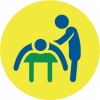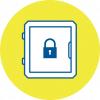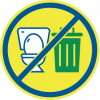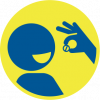Get Informed About Opioids
Opioids can be the right prescription for pain, but they carry risks. Anyone can develop problems from using opioids. Learn how to manage your pain safely.

What You Need To Know About Your Prescription

You may have an opioid prescription and lots of questions. Read below to learn more about opioids, how we use them, and why they can be dangerous if used incorrectly.
Managing Your Prescriptions Safely and Responsibly
Opioids are very powerful medications that can be the right treatment for pain, but they come with risks. Here are easy ways to protect yourself and your loved ones.

Limit your use
Unlike antibiotics, you do NOT need to take all opioids prescribed to you. Stop taking opioids as soon as your pain is tolerable. The less you take, the safer you are from negative consequences like dependence, addiction and overdose. Ask about non-addictive alternatives. There are many ways to treat pain without opioids, such as physical therapy, non-opioid medicines and compresses.
Non-opioid alternatives
Alternatives to opioids may be covered by your insurance provider. These commonly include:
- Non-medication options, like ice, heat, massage, gentle exercise, meditation, acupuncture, stretching, yoga.
- Non-opioid medicines (oral and topical), like acetaminophen, ibuprofen, cyclobenzaprine, lidocaine ointment.
- Therapy to modify emotional and physical triggers of pain and stress.
Many of these pain treatment options can be used at the same time.

Safely store
Keep your prescription out of reach of children, like in a locked container. It might seem extreme, but locking up your prescription opioids is the best way to keep children or other loved ones from accessing your pills and will prevent them from accidentally overdosing. Be sure to keep them out of common areas like kitchen or bathroom counters, coffee tables, or on top of nightstands. Don’t share. Your prescription is meant for you only. Do not share with others. Remember, your prescription is meant for your specific needs and a dose that is safe for you could be dangerous for someone else.

Get rid of leftovers quickly
Do not keep opioids for future use. If your pain returns, it means you have not fully healed and may require another type of treatment. Keeping your pills may provide access to others and put them at risk. Safely dispose by returning leftover pills to a safe disposal site near you. Help keep our water systems and landfills clean by NOT throwing them out or flushing them down the toilet. Find more information on how to dispose of your pills in Oregon, Washington, and Alaska.

Parents use precaution with children who are prescribed opioids
If you are a parent of someone prescribed opioids, it is especially important to follow these precautions. Dispense medicine to your child EXACTLY as prescribed. It can be hard to say no to a child in pain, but opioids are risky and giving them more than prescribed can put them at risk. Do not take opioids yourself and store in a secure place to prevent anyone else from taking them.

What Happens When Opioid Use Becomes a Problem?
Opioids are very powerful, and problem use can happen very easily. Anyone can have a problem using opioids, so it’s important to learn the warning signs and take action immediately.
Who is at risk?
Using opioids, even as prescribed, can lead to problems like dependence and addiction if a person isn’t careful. Misusing opioids, like taking more than prescribed or taking with alcohol, can seriously increase the likelihood of an overdose. Even people with no history of substance use can develop a dependency and addiction to opioids (Opioid Use Disorder). It can only take a few days.
How will I know there's something wrong?
Common signs of dependence or addiction you should look for in others are:
Unexplained change in:
- Attitude
- Appetite
- Sleep patterns
Personality, such as:
- Mood swings
- Irritability
- Angry outbursts
- Sudden changes in social behaviors, like friends, favorite hangouts or hobbies.
- Engaging in secretive or suspicious behaviors.
- An unexplained need for money.
- Common signs of dependence and addiction to look for in yourself include:
- Craving more of the substance, even after your pain goes away.
- Experiencing headaches, nausea or sweats if you have not taken opioids in several hours.
If you are concerned about your own or a loved one’s opioid use, take immediate action. It is important to act quickly before things get worse. Remember, anyone can have a problem with opioid use. Seeing the signs of a problem early and taking action is the right thing to do and can save a life.
Talk to your doctor immediately. They are there to help keep you healthy and safe, and can help you find non-opioid alternatives to manage your pain or get support.
Emergency? CALL 911
An opioid overdose can look just like sleeping. If someone is unresponsive and you suspect an overdose is happening, call 911 and administer naloxone (Narcan®), a life-saving medications that can reverse an overdose, according to directions.
Signs of an overdose include:
- Not breathing, slow/shallow breathing
- Unresponsiveness, unconscious
- Blue lips and/or nail beds
- Snoring, choking, or gurgling sounds
- Small “pinpoint” pupils Pale or blue, cold, sweaty skin
